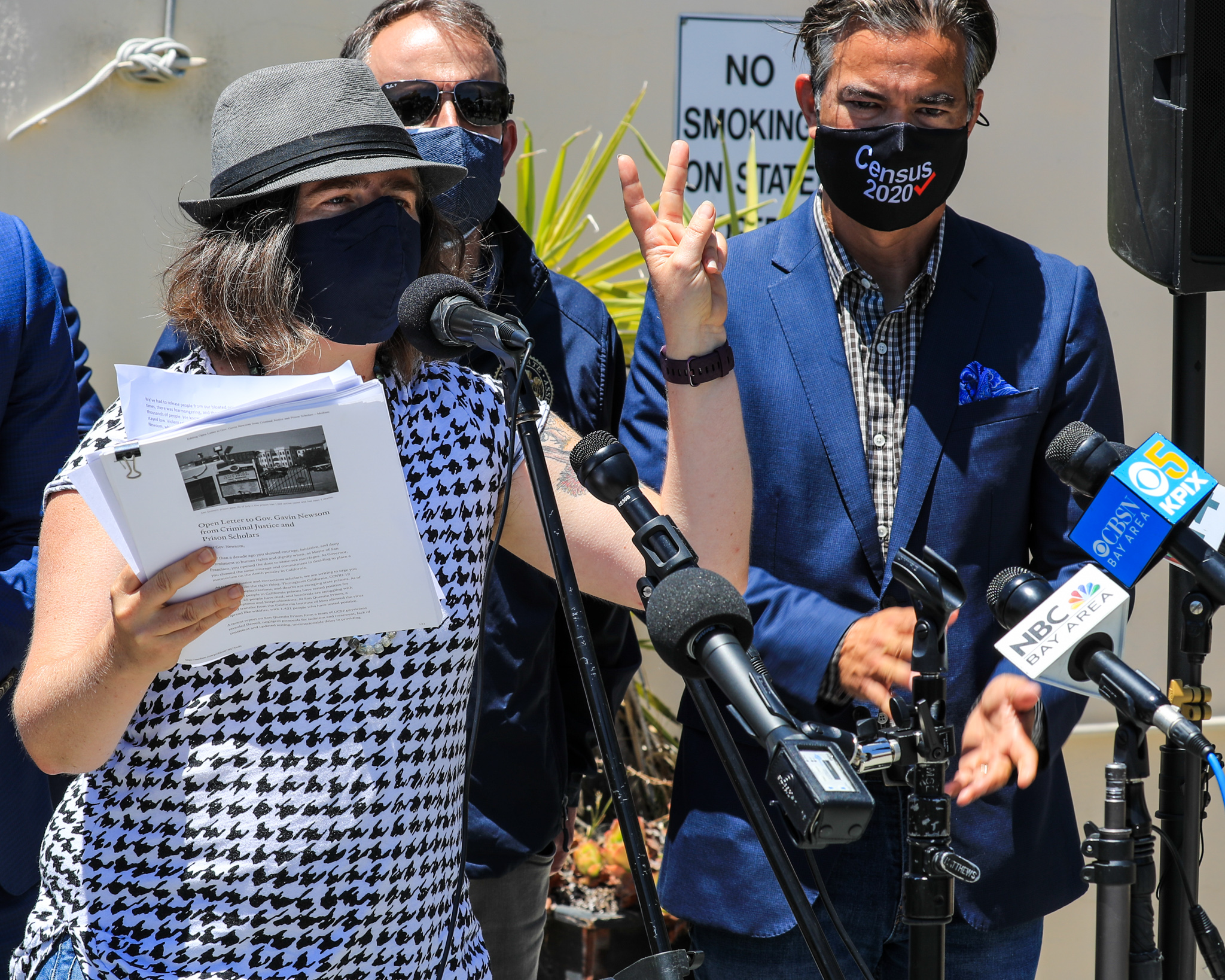

More than a decade ago you showed courage, initiative, and deep commitment to human rights and dignity when, as Mayor of San Francisco, you opened the door to same-sex marriages. As Governor, you showed the same courage and commitment in deciding to place a moratorium on the death penalty in California.
As criminal justice and corrections scholars, we are writing to urge you to once again do the right thing. Throughout California, COVID-19 infections, hospitalizations, and deaths are ravaging state prisons. As of July 6, 5,343 people in California prisons have tested positive for COVID-19, 25 people have died, and hundreds are struggling with active symptoms and hospitalizations. At San Quentin Prison, a botched transfer from the California Institute of Men allowed the virus to spread like wildfire, with 1,421 people who have tested positive.
A recent report on San Quentin Prison from a team of UCSF physicians revealed flawed, negligent protocols for isolation and treatment, lack of consistent and updated testing, unconscionable delay in providing testing results, inappropriate grouping of staff members, and physical locations for isolations that are terrifying and alienating to the population. These inadequate practices are happening against the backdrop of prisons already bursting at the seams, with many of them overcrowded not only well beyond their design capacity, but over the 137.5% limitation set for the entire correctional system by federal courts more than a decade ago.
The men and women in California prisons are serving sentences meted out by law. The California Penal Code did not sentence them to neglect, abuse, illness at  overcrowded institutions with the potential to become mass graveyards. As to those falling ill and dying on death row, surely your moratorium on the death penalty, and the decades and billions of dollars spent litigating capital punishment protocols, should not end with deaths by COVID-19.
overcrowded institutions with the potential to become mass graveyards. As to those falling ill and dying on death row, surely your moratorium on the death penalty, and the decades and billions of dollars spent litigating capital punishment protocols, should not end with deaths by COVID-19.
Moreover, COVID-19 infection is not a zero-sum game, and prioritizing the prison crisis does not come at the expense of the state overall — rather, it protects all of us. In both Marin and Lassen counties, spikes in community infections followed closely after spikes in infection within state prisons; all correctional institutions are permeable to the outside through staff mobility. Protecting people in prison protects people outside prison, too. By contrast, incubating the virus at our state prisons puts the entire state at risk, potentially rendering all your important prevention work, all the efforts at public education about masks and social distancing, and the immense sacrifices of all Californians futile.
We urge you to exercise all the powers at your disposal and release people from prisons to their communities — not just at San Quentin, but systemwide. Given the overcrowding and contagion spread, the release of a few thousands is but a drop in the bucket. A robust body of research in our field confirms that such releases, via executive orders, clemency, and parole (hundreds who have been found eligible for parole are still behind bars), will not endanger public safety. A quarter of the California prison population is aged 50 years and older; this population consists largely of people whose crimes of commitment were committed decades ago, and who do not pose any public risk, violent or otherwise. Previous declines in the California prison population, through the Criminal Justice Realignment and through Prop. 47, did not put the public at risk. We urge you to follow solid findings in criminology, public policy, criminal justice, and public health, rather than misleading and fear-mongering media reports.
We appreciate and admire your willingness to courageously do the right thing in previous pivotal moments; your initiative on same-sex marriage and on the death penalty moratorium have shown your prescience and will be remembered kindly by history. This is precisely such a moment. We urge you to lead us in the right direction.
Respectfully,
Hadar Aviram, Thomas E. Miller ’73 Professor of Law, UC Hastings College of the Law
The letter was signed by hundreds of faculty and scholars, for the full list see here.
To sign up for our new newsletter – Everyday Injustice – https://tinyurl.com/yyultcf9






This is untrue.
I assume he researched, please show me yours.
Oh puh-lease. Anytime hardened criminals are released it puts the public at some level of risk.
You stated that something was untrue – what is untrue, and what evidence do you have to back that?
Are you really going to try and say that releasing hardened criminals into the public doesn’t pose some level of risk?
There’s a difference between something being factually untrue and something that you disagree with. I was attempting to ascertain whether there was a factual error. It now appears that this is about a difference of opinion – am I correct on this?
In terms of your opinion, the proposal as I understand is threefold: (1) release people who have less than a year left to serve, (2) release people over the age of 60, (3) release people who are evaluated as low risk. Which group do you deem posing a heightened level of risk?
So Keith, I’m not sure what you mean by “hardened criminals”, maybe you could better define what you mean. And of course there is some risk for all releases. But you should remember that the average prison term in California is about two years. And again, crime rates have continued to drop over the last 20 years which suggests that there are substantial numbers of inmates who do not recidivate. Rates overall in California have continued to drop after Prop. 47 and AB 109 Realignment. The only overall category that has risen some is property crimes.
There is plenty of data out there (try Bureau of Justice Statistics to start) that show that once an individual is over 40, their rates of re-arrests goes way down.
And it is true that about 25% of California are older. That’s because many were committed with long sentences and when they were in their 20s and 30s.
I’m not sure where you get your information but it would be helpful for those who read the Vanguard if you put in some references.
My data comes from the CDCR DataPoints publications which are available online and the Bureau of Justice Statistics which collects and reports data from all over the U.S.
Robert, you just proved my point. The open letter stated “do not pose any public risk, violent or otherwise” and “did not put the public at risk” which we know is untrue.
I think in context it is an accurate statement: “. A quarter of the California prison population is aged 50 years and older; this population consists largely of people whose crimes of commitment were committed decades ago, and who do not pose any public risk, violent or otherwise.”
Technically I would say less than one-percent is extremely low risk rather than no risk but I would be comfortable backing this statement.
Nothing is without some risk, but it’s a question of weighing the risks and benefits of taking action against those of failing to act. Failing to act means an inevitable increase in loss of human life within the prison. It means risk of exposure by prison personnel and consequent spread to the community.
Okay, so being there are 3 million cases of COVID in our country of 335 million which puts it at less than 1% would you also call that “extremely low risk” and be comfortable backing a statement of “no risk”?
I would add that “hardened criminal” is a loaded term that stereotypes people whose situations vary widely. As long as we’re making speculative predictions, I’d also consider that spending time in prison results in increased hardening and thus increased risk upon ultimate release, whereas showing compassion through early release may have a positive, mitigating effect and thereby reduce risks to the community.
“This is untrue”
This assertion is quite vague. It is unclear precisely what you believe is ” untrue”. So I broke it down to component parts and consulted with my resident expert in California prisons. As it turns out, the “truth” is always complicated.
1. “A quarter of the California prison population is 50 years or older “- true.
2. This population consists largely of people whose crimes of commitment were committed decades ago – likely true depending on how one defines ‘largely”.
3. “Who do not pose any public risk violent or otherwise” – while the use of the word “any” makes this an exaggeration since there is some risk associated with any action or lack thereof, current criminology along with statistics of recidivism would demonstrate this statement to be “largely” true.
Still an untrue statement as written.
Why is it so important that you parse these words so narrowly?
Why is it so important to you to not admit that the words as written are untrue?
Keith
There are some to statistics from cdcr the age groups are on page 34
Granted there is roughly 25% of the population over the age of 50 but a lot of these individuals are various very dangerous individuals murderers rapist etc people you really don’t want on the street I hope this link I sent you works
https://drive.google.com/file/d/1CCNXlUMZD6hOYDQSh8ATiRJlfXLJjuux/view?usp=drivesdk cm
Thanks Chris, it’s ludicrous to say that releasing criminals will not pose any public risk. Who do they think they’re fooling?
They are just simply fooling themselves. And some of them actually know that you’re right they just like to be confrontational that’s part of the fun posting on Davis vanguard 😊
It’s true that the letter states that there is no risk by releasing inmates over 50 and whose crimes were decades ago. They overstate the facts.
So I would ask you, who should we release to relieve the disease burden in the prisons? San Quentin is not the only CDCR prison to have a COVID spike and problems.
If everybody came down with the coronavirus could you catch the coronavirus a second time?
That’s a big question going forward – will this be like the measles, you get it, you can’t get it again. Or like the flu or cold, and you can get it again.
DeAngelo should be released immediately… he meets the age and health criteria… unlikely he will murder or rape again (he confessed)[perhaps the innocence folk can take up his case… false confessions, etc.]… he is at risk for Covid… he is an ex-cop… he should be freed immediately!
To put him in prison is a serious risk to his health… on several counts…
Yeah. Right…